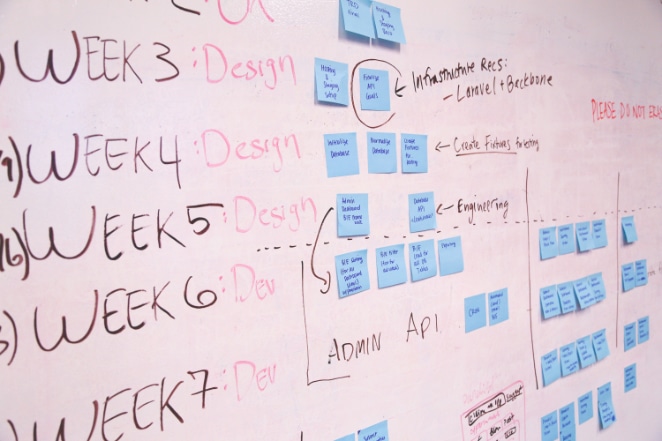
Why Designers Need a Project Management System
When it comes to managing your workload and your workflow, one of the most critical things you need is efficiency.
If time truly equals money, then it follows that time wasted is money wasted. The more efficient and smoothly flowing the pieces of your design practice are going, the better your bottom line will be…not to mention a much easier mental load.
One of the keys to an efficient workflow is systems. Systems are frameworks and tools you use to govern – and sometimes even automate – the more repetitive aspects of your work. There are all kinds of systems for all kinds of things, and the one we’re going to focus on today is project management.

As a designer, a basic understanding of the importance of project management – along with some tools you can use to manage your client projects – can go a long way toward making your work life tremendously easier.
Why Project Management Matters
Project management can be as simple as keeping a handwritten to-do list, and it can be so complex that large companies require multiple project managers on staff just to keep things moving. In web design, when you’re a single designer working with a client that offers maybe one to three people whose opinions need to be considered, project management typically falls on the simpler side of the spectrum – but that doesn’t mean that it’s a simple thing.
In short, project management basically means you’re staying on top of any given project. You know what needs to be done, and when, and by whom. If you’re involved in decision-making at any level in a web design project, you’re already doing some project management. The question is, are you doing it the right way?
Is your project management something that works for you, making your work life easier, even going so far as to automate some things on your behalf (or the client’s behalf)? Or are you having to track, manage, send emails, check in, send reminders, review, and constantly shuffle through project elements day in and day out?

If you ever struggle with the sense that your client work is “getting away from you” somehow, a solid project management tool might be just the thing you need. And these days, there are quite a few options to choose from.
What to Look for in a Project Management Tool
Ultimately, good project management should make your job easier. Any project management tool that you use should make the process as smooth, seamless, and transparent as possible.
If you’re used to scrawling out weekly updates with a “who needs what” to-do list, and constantly checking and wondering about the status of things through the week, it’s time for a project management tool.
These are some of the things a great project management tool can offer you:
- A to-do list or task list of some sort, with a way to assign tasks and/or deadlines to individuals involved in the project
- Browser-based access (and an app is valuable, too)
- The ability to invite “outsiders” to use the tool (so you can assign them tasks, too)
- The ability to see a full list of all your current tasks (or all the tasks assigned to someone else)
- Built-in project and task list templates you can build so that you aren’t starting from scratch every single time
- Automated emails for notifications and reminders
- A mechanism for discussion and feedback (aka comments)
- A calendar that offers built-in reminders and notifications
- A place where you can upload or otherwise connect documents, images, graphics, and other digital files
- The ability to keep each individual project self-contained so project discussions aren’t constantly overlapping and getting muddled
When you have all of these things at your disposal, you’ve got a great tool.

Two of the leading project management tools right now are Asana and Basecamp (my personal favorite). Asana has a very “slick” feel to it, with a beautiful aesthetic and all kinds of functionality. I prefer Basecamp because the navigation goes across the top rather than down the side (which I prefer) and it was also the first one I ever used and thus earned my undying loyalty.
Your Two Best Friends are Task Lists and Email Reminders (Plus Comments)
Task lists are fantastic – I especially love the ones that come with a satisfying check box – because they lay out exactly what needs to get done. Make use of the deadline feature and the ability to assign tasks to specific individuals, and no one has to ask what the status is on anything ever again. Just log in, see what’s checked off and what’s not, and check out any of the discussion comments if applicable.
[article id=”18628″ align=”right”]
Hand in hand with these task lists is the email reminder feature. No more having to check in with a client to be sure they’re prepared to offer the feedback that’s due tomorrow – and no more having to follow up with a client that didn’t submit feedback on the agreed-upon due date. Your project management software should be sending those notifications automatically. (Bonus points if you’re able to edit the notification to include a reminder of what will and won’t happen when the client doesn’t do his or her part to keep things moving forward!)
The comments are awesome, too. Instead of having a million emails to store and sift through, comments directly on each task or project element can (and should) be made right in the project management software, which makes referencing those thoughts infinitely easier down the road.
The Bottom Line with Project Management
Ultimately, a good project management tool allows you to communicate effectively. [twitter_link]The cornerstone of any great design project is clear communication from everyone involved.[/twitter_link] By having everything spelled out “right there” for all to see, having all the peripherals in place to discuss and iterate, and deadlines and milestones (with reminders) built right in, nothing is left to chance or guesswork.
And that is key to a smooth, high-functioning workflow.











